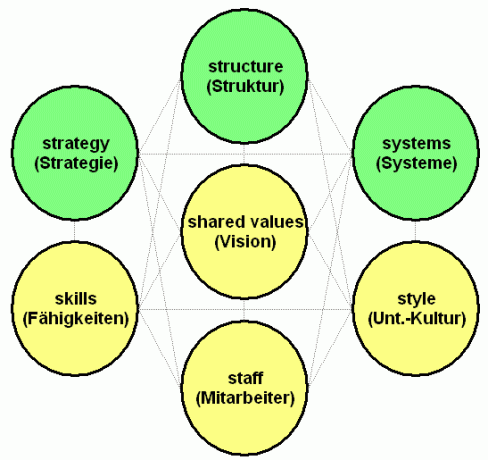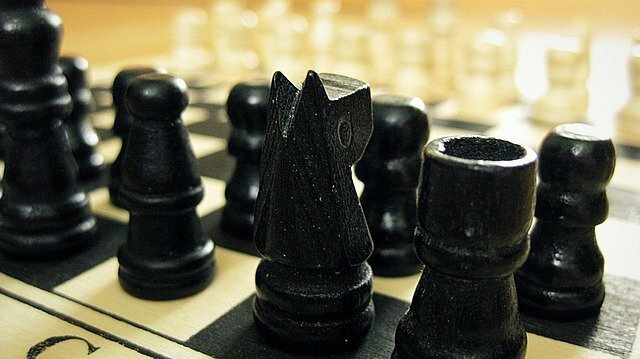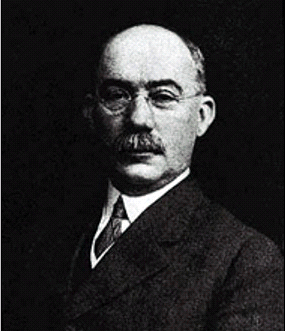The McKinsey 7s model It was developed in 1980 by McKinsey consultants Tom Peters, Robert Waterman, and Julien Philips with the help of Richard Pascale and Anthony G. Athos. Since its introduction, the model has been widely used by academics and practitioners and remains one of the strategic planning tools More popular. In the beginning it was tried to emphasize human resources (Soft S), instead of the traditional tangible elements of mass production such as capital, infrastructure and equipment, as a key to higher performance of the organization. The objective of the model was to show how the 7 "s" of the company: Structure, Strategy, Skills, Personnel, Style, systems, and shared values, can be aligned together to achieve effectiveness. The key point of the model is that the seven areas are interconnected and a change in one area requires a change in the other 6 to function properly.

Advertisements
Below you can find the McKinsey model, which represents the connections between the seven areas divided into "Soft s" and "Hard s'. The idea is to emphasize the interconnectedness of the elements.
The model can be applied to many situations and is a valuable tool when organizational design is in question. The most common uses are:
Advertisements
- Facilitate organizational change.
- Help implement a new strategy.
- Identify how each area may change in the future.
- Facilitate the merger of organizations.
In this article you will find:
McKinsey 7s
In the McKinsey model, the seven organizational areas are divided into "hard" and "soft" areas. Strategy, structure and systems are the hard elements that are much easier to identify and handle compared to the soft elements. On the other hand, soft elements, although more difficult to handle, are the foundation of the organization and are more likely to create a advantage sustained competitive. The term "7s" comes from the initials of the concepts in English.
| S Hard | S Soft |
| Strategy | Style |
| Structure | Staff |
| Systems | Skills |
| Shared Values |
Advertisements
Strategy is a plan developed by a company to achieve sustained competitive advantage and successfully compete in the marketplace.
What does a well-aligned strategy mean in the McKinsey 7s model?
Advertisements
In general, a good strategy is one that is clearly articulated, defined in the long term, helps achieve a competitive advantage, and is reinforced with vision, mission, and values. But it is difficult to know if this strategy is well aligned with other elements when analyzed alone. So the key in the 7s model is not to look at the company from the point of view of strategy, structure, systems, etc., but to see if it is aligned with other elements. For example, the short-term strategy is generally a poor choice for a company, but if it is aligned with the other 6 elements, then it can give good results.
The 7s are listed below
Structure- Represents how the company is organized into divisions and business units and includes information on who is accountable to whom. In other words, the structure is the organization chart of the company. It is also one of the most visible and easy to change items.
Advertisements
The systems: are the processes and procedures of the company, which show the business, daily activities and how decisions are made. Systems are the area of the company that determines how to do business and should be the main focus of managers during organizational change.
The abilities: are the skills of the company's employees. They also include skills and competencies. During organizational change, the question that often arises is what skills the company really needs to reinforce its new strategy or new structure.
Personal: it has to do with the type and number of employees that an organization will need and how they will be recruited, trained, motivated and rewarded.
Style- Represents how the company is run by senior managers, how they interact, what actions they take, and their symbolic value In other words, it is the management style of the leaders of the company.
Shared values: They are the core of the McKinsey 7s model. They are the norms and criteria that guide the behavior actions of the company and of the employees and, therefore, are the basis of any organization.
Like any model, this can be well or badly applied. This is a useful template for taking a picture of the business and comparing it to the desired state. Visually show how everything is linked to understand the implications of a change. It is very similar to how a general practitioner can help diagnose a patient's situation, but the honed skill of a surgeon is what is used to make the necessary changes.
Did you know this model for strategic planning?


